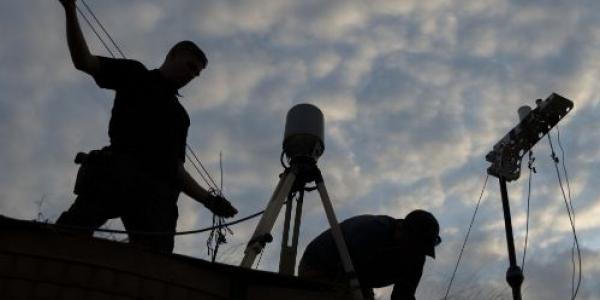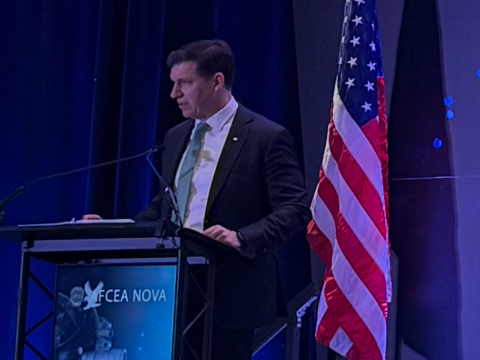Smart Spectrum Sharing
Accessible radio frequencies are crucial for warfighter training, testing and operations. Ensuring access to the necessary electromagnetic spectrum for U.S. Defense Department missions is not an easy task, especially in a time of growing demand across the military and commercial sectors, explains Col. Frederick Williams, USAF, acting director of the Office of Spectrum Policy and Programs, Office of the Secretary of Defense, or OSD. The military operates in a wide range of spectrum bands, both on an exclusive and shared basis. In the last several years, Defense Department operational requirements for spectrum access have increased. To meet growing demand, the office is looking into how the military can share additional frequencies with other agencies or the commercial sector. Meanwhile, the evolution of mobile broadband 5G and beyond telecommunications, as well as the demand for spectrum, is creating additional congestion in the airways, thus complicating matters.
The Office of Spectrum Policy and Programs, which is located within the Office of the Deputy Chief Information Officer (CIO) for Command, Control, and Communications within the Defense Department CIO office, is charged with orchestrating spectrum access for Defense Department readiness, and it is a challenging era, says Col. Williams.
“DOD [Defense Department] spectrum needs are growing, and gaining spectrum access in the traditional sense is getting harder and harder,” he says. “New capabilities, integration of capabilities, new mission sets, increased scope size, frequency of testing and training events are all causing congestion within the spectrum, just internally. At the same time, near-peer competitors are fielding capabilities to contest our ability to use the spectrum when we desire.”
The office helps set electromagnetic spectrum policies, strategies and plans; develops and coordinates Defense Department positions regarding electromagnetic spectrum matters; and provides expertise to resolve electromagnetic spectrum issues within the Defense Department and across the government and U.S. spectrum regulatory agencies, including the Federal Communications Commission (FCC) and the National Telecommunications and Information Administration (NTIA)—as well as the international arena. The office also works closely with the Defense Information Systems Agency’s Defense Spectrum Organization and the military departments to find efficiencies for user access and management of electromagnetic spectrum, the colonel relays.
Col. Williams leads a team of approximately 25 personnel, including electrical engineers, radio frequency engineers, telecommunications specialists and policy and regulatory experts, to handle those efforts. In conjunction with other OSD entities, the team is developing a Defense Department electromagnetic spectrum (EMS) enterprise policy and updating its 2013 EMS strategy to guide access and use of spectrum.
In addition to expediting capability developments to operate in a contested and congested spectrum environment, the measure will support spectrum sharing and focus on achieving improvements in digital modernization, spectrum data transformation and automation, and improved integration of business processes to increase efficiencies in electromagnetic spectrum operations, he says.
The incredible growth from the industry for spectrum—which adds to the Defense Department’s demand—is what makes spectrum management so tricky at present, the colonel suggests. “We have seen just enormous growth in the commercial broadband area, and that is causing great congestion because those broadband companies need spectrum to execute,” he says. “And so, it’s pinching not just the nonfederal commercial side of things, it’s also pinching the federal side of things. So these combining effects are causing great attention to be placed on spectrum.”
The Defense Department “fully supports” the developments of 5G by the commercial sector. “The potential to keep the U.S. economy the greatest in the world is very important to us,” he exclaims. “But at the same time, we have to ensure we have no loss to capabilities or missions for our national security efforts.”
5G is unique, however, in that it offers capabilities to the military that previous telecommunications have not. “One of the big pivots for DOD in terms of priorities has been the acceptance of 5G broadband,” Col. Williams states. “It’s the first time we’ve really looked at mobile broadband as something where we can reap the benefits of and apply these technologies to DOD operations and missions.”
As part of the National Spectrum Strategy, the OSD also is preparing key studies that focus on ensuring U.S. leadership in 5G. For spectrum management, this involves making spectrum available for 5G in three areas: low-, mid- and high-band. Col. Williams clarifies that the mid-band spectrum level is the priority for 2020 to 2022 and that the Defense Department is working closely with national regulators, the FCC, the NTIA and other federal entities to make that swath of spectrum available to the commercial sector.
One of the areas the office has been working on in particular is the 3.55 to 3.65 gigahertz (GHz) range, better known as the Citizen Broadband Radio Service (CBRS). It will be the first mid-band spectrum sharing that the United States makes available for 5G. Efforts are on track for an auction in June of 2020, the colonel states. “DOD largely occupies the 3550 to 3700 megahertz band, and we have completed about five years of work with the FCC building a framework to share that spectrum,” he notes. “That framework is set, and it’s going forward, and there’s going to be sharing in that band between DOD, FCC license holders and unlicensed users as well.”
Sharing of that spectrum is controlled through a system that determines where a user has access at a particular location. An environmental sensing capability is deployed on the coasts to monitor the presence of the Navy and Marine platforms and informs the spectrum access system that a user will be operating on the spectrum.
“It’s a massive deconfliction of all of the users, avoiding the DOD when the DOD is using the spectrum,” Col. Williams says. “When DOD is not using the spectrum, then they share it. We’re real excited about it. It’s going to teach us a lot about these types of sense and avoid systems that are being fielded.” The office also is working with the NTIA to study the 3.4 to 3.55 GHz band, which is another important piece of mid-band spectrum for 5G. “That may even extend down another couple hundred megahertz (MHz), down to the 3.1 GHz range,” he adds.
In December, the Defense Department released two draft requests for prototype proposals seeking 5G wireless solutions (See page 24). One prototype project that the Office of Spectrum Policy and Programs will be heavily involved in focuses on 5G dynamic spectrum sharing. “That’s expected to be set up at Hill Air Force Base, Utah, in combination with the DOD and the United States Air Force, to develop effective methodologies, hardware, software and systems for spectrum sharing or coexistence between airborne platforms, such as airborne radar systems and 5G cellular systems, either in completely or partially overlapping spectral bands,” Col. Williams shares. “And that’s a fresh initiative where the technology will allow us to assess that type of sharing scenario.”
Next, a tri-agency partnership with the Department of Homeland Security and the Federal Aviation Administration involves the potential sharing of the 1300 to 1350 MHz band. “We’re taking a look to determine if those federal agencies can develop a Spectrum Efficient National Surveillance Radar, while at the same time open that spectrum up for commercial broadband uses as well,” he offers. Additional work with the National Oceanic and Atmospheric Administration (NOAA), as part of a two-year NOAA-led study, is examining the potential sharing of federal meteorological and hydrological capabilities in the 1675 to 1680 MHz band with commercial broadband companies.
Already, the Defense Department has found success in the sharing of advanced wireless service-3 (AWS-3) spectrum bands—not to mention past AWS-1 sharing efforts—and is continuing to transition capabilities from the 1755 to 1780 MHz band, which were part of the AWS-3 auction from 2015. “Some of those equities have executed their transition plans already, and some are still in the process and will continue past the 2022 time frame,” he notes. “To mitigate the risk in transition, DOD established the Spectrum Access Research and Development program. This program, exploiting federal, industry and academic partnerships through the National Spectrum Consortium, is executing more than 27 lines of effort to develop and integrate technologies to better access, use and manage the spectrum.”
For the second part of AWS-3, the meteorological and oceanographic (METOC) band, the department is “postured for industry to come in and make proposals to enter the METOC band to start sharing that spectrum,” the colonel adds. “We’ve done everything on our end in the 1695 to 1710 MHz band. The DOD sites, largely in the Air Force, Navy and Army, are protected. They’re called coordination zones. The mobile broadband entities that desire to share that spectrum have to coordinate and avoid causing interference to the DOD downlinks. That process is ongoing and is working very well.”
Regarding the 37 GHz band, the FCC is holding one of the first high-band 5G auctions for that spectrum. The military still has a number of sites protected in that band, “but we’re working with the FCC, NTIA and industry to have some primacy for DOD operations, experiments and some of the things that we expect to do up in millimeter wave as we go forward and start pursuing 5G capabilities.
“Spectrum is a finite resource and when you run out of it, one of the things you have to look at is sharing,” Col. Williams states. “The technology today allows us to do something that we think is going to be very viable in the future, and that’s cognitive cohabitation, where you have machine-to-machine managing and deconflicting themselves. And we’ve shown some success in doing that. You certainly can’t do that everywhere with all the capabilities, but where it makes sense, we’re really looking forward to pushing the envelope.”
You may also enjoy:
NSF Researchers Explore a Wireless World Beyond 5G




Comments